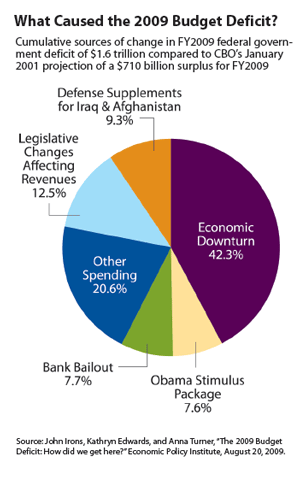
How I Learned to Stop Worrying
and Love the Deficit
This article is from the November/December 2009 issue of Dollars & Sense: Real World Economics available at http://www.dollarsandsense.org

This article is from the November/December 2009 issue of Dollars & Sense magazine.
Subscribe Now
at a 30% discount.
The Pelosi-Obama Deficits
[C]urrent U.S. fiscal policy is “borrow and spend” on a hyperlink. The ... deficit for 2009 will be “only” $1.58 trillion .... But the Obama fiscal plan envisions $9 trillion in new borrowing over the next decade.
We’ve never fretted over budget deficits, at least if they finance tax cuts to promote growth or spending to win a war. But these deficit estimates are driven entirely by more domestic spending and already assume huge new tax increases.
[T]he White House still hasn’t ruled out another fiscal stimulus.... Obamanomics has turned into an unprecedented experiment in runaway government with no plan to pay for it, save, perhaps, for a big future toll on the middle class such as a value-added tax.
—from an op-ed in the Wall Street Journal, 9/26/09
You would have thought the federal budget deficit had morphed into Dr. Strangelove’s doomsday machine from the howling that followed the publication of the Congressional Budget Office (CBO) projections in August. The Wall Street Journal editors were happy to join in despite assuring readers that they are not deficit-phobic.
But the truth is, government spending and the budget deficit it engendered are what stood between us and an economic doomsday that would have rivaled the Great Depression of the 1930s. In that context, the Obama budget deficits are neither all that big nor all that bad, although they sure could have been better had the spending priorities been more progressive. And even larger deficits could have done—and still could do—more to alleviate the economic suffering that continues unabated even as the economy begins to stabilize.
How Big Is It?
Even after correcting for inflation, $1.58 trillion is a record federal budget deficit. But this eye-popping number needs to be seen in context.
A trillion and a half dollar deficit will equal 11.2% of Gross Domestic Product (GDP) for 2009, according to CBO estimates. That too is a record for “peacetime” deficits. The Reagan deficits in their worst year reached 6% of GDP. During World War II, however, military spending pushed the federal deficit to qualitatively different levels, reaching 31.3% of GDP and never dropping below 14.5% during the war years 1942 to 1945.
Whatever its size, before pinning the 2009 deficit on runaway government spending, it’s important to assess how much the collapsing economy contributed to the deficit. Big government bashers like the Journal editors would have you believe that the entire budget deficit was brought on by reckless government spending.
That is hardly the case. The collapsing economy added more to the deficit from 2007 to 2009 than any other factor. As economic activity dried up, personal and corporate income tax revenues plummeted: this year government revenues will drop to 14.9% of GDP, their lowest level since 1950. Plus, the crashing economy automatically pushed government spending on unemployment insurance and food stamps up, further widening the deficit. Even the financial-sector bailout and the Obama stimulus package taken together did less to swell the deficit than the economic collapse did.
To control for the effect of the business cycle on the budget deficit, economists look at the so-called standardized, or cyclically adjusted, deficit—the deficit that would occur if the economy was always operating at the peak of the business cycle, in other words, at its “potential GDP.” Standardized deficit figures indicate that the 2009 budget is highly stimulative but hardly disproportionate to the economic emergency it confronted. In 2009 the cyclically adjusted deficit will reach 8.6% of potential GDP, and then shrink to 3.4% by 2011, according to CBO estimates. The previous high was 4.7% in 1986 (with data back to 1962), in the midst of the “borrow and squander” Reagan years when the only emergencies facing the nation were the desire of the rich for a tax cut and the drive to expand cold-war military spending. Under George W. Bush, tax-cutter to the rich extraordinaire, the cyclically adjusted deficit reached 3.1% in 2004, the near equal of the projected 2011 figure.
The CBO projected deficits will add $9 trillion in the next decade to the national debt, the cumulative amount of money the government will have borrowed to finance its annual deficits.
That is another frightening number, but it too needs to be seen in context. For instance, publicly held federal-government debt will reach 67.8% of GDP in 2019, according to CBO projections. That number would be the largest ratio of debt to national output since 1952, but still not in the same ballpark as the 120% figure at the end of World War II.
But absent the stimulus, the federal government would face yet larger deficits as the economy and federal tax revenues fell further. And unlike World War II spending that sparked a 20-year economic boom, a do-nothing strategy would be followed by a depression that would impose far greater costs than escalating government debt.
Domestic Spending Gone Wild?

The Journal’s editors are correct that it is not the size of the deficit that is worrisome, but its content—the spending and taxing policies that brought it about. But on that count they really should not be complaining, because it was the tax cuts and military spending they favor that played a decisive role in pushing the federal budget out of the black and into the red.
When the Bush administration took office in 2001, the CBO projected the federal government would run a budget surplus of $710 billion in FY 2009. The CBO now projects a $1.6 trillion budget deficit. The Economic Policy Institute found that the bad economy (slow growth and then the crisis) and Bush administration tax and spending policies (from the 2001 and 2003 tax cuts, to spending on Afghanistan and Iraq, to Medicare prescription drug coverage) each caused about 42% of that $2.3 trillion budget swing. Following by quite a distance were the Obama stimulus package and the TARP bailout, accounting for 7.6% and 7.7% of the budget swing respectively. Supplemental defense allocations for the Iraq and Afghanistan wars accounted for more of the increase in the deficit (9.3%) than either program (see figure).
Nor do the CBO numbers justify the editors’ claim that we are about to enter a period of runaway government and deficits “driven entirely by more domestic spending.” Discretionary domestic spending (federal government spending on education, housing, infrastructure, and the like) will average 3.7% of GDP over the 2010 to 2019 period—no higher than in 2008, the last year of the Bush administration. Mandatory domestic spending (including Social Security, Medicare, Medicaid, and unemployment insurance) will average 12.8% of GDP over the next ten years, 1.6 percentage points more than in 2008. Even that jump in what is, after all, already-obligated spending will account for just two-fifths of the federal deficits that the CBO projects for the next ten years. That is hardly domestic spending gone wild.
The True Test
Obama administration policies might not have been the chief cause of the 2009 deficit or the $2.3 trillion budget swing from black to red ink over this decade, nor will they commission runaway domestic spending as the editors allege.
But that alone does not make the president’s policies successful. The true test of any deficit-spending policy is whether it makes people better off. The policies endorsed by the editors have failed that test miserably. Worse yet, they saddled us with large deficits that now block the very spending proposals that might pass that test. Whether it is spending for universal health care, green technology, infrastructure repair, or school renovations—or help for those who have lost their homes—the new refrain is that spending must not “add one dime to the deficit.”
A second dose of deficit-financed stimulus spending, a notion the editors dismiss out of hand, would create jobs desperately needed as even official unemployment rates are likely remain at double-digit levels through much of 2010.
In a very real way, our jobs and our prospects for living in a fair society depend upon learning to stop worrying and to love the deficit.
Did you find this article useful? Please consider supporting our work by donating or subscribing.
